This is a Miranda Sensomat 35mm SLR camera made by the Japanese Miranda Camera corporation. Although marketed as a budget model, the Sensomat line of cameras featured several features found in much more expensive cameras such as an interchangeable prism and stop down TTL metering. The Miranda Camera Corp manufactured almost all of their cameras in-house without outsourcing parts. Although this meant that their products were well built and durable, it prohibited them from competing with larger Japanese camera makers of the time, eventually leading to the company going bankrupt in 1976.
Film Type: 135 (35mm)
Lens Mount: Miranda Bayonet and 44mm Screw Mounts
Lenses: 50mm f/1.8 and 28mm f/2.8 Auto Miranda
Focus: Removable SLR Prism
Shutter: Focal Plane Cloth
Speeds: B, 1 – 1/1000 seconds
Exposure Meter: TTL Behind the Mirror CdS Sensor with Match Needle Exposure
Battery: PX675 Mercury Wein Cell
Flash Mount: PC Sync
Manual: http://www.butkus.org/chinon/miranda/miranda_sensomat/miranda_sensomat.htm
History
When most people think of a Japanese camera company, the first two that pop into most people’s minds are usually Nikon or Canon. For those that don’t instantly come up with the ‘big two’, other names like Olympus, Minolta, Konica, or Pentax ring a bell with most people. A name that probably wouldn’t come up if you asked this same question to 1000 people is Miranda.
Type the word “Miranda” into Google and you’ll get articles about a BBC Television show, Miranda Lambert, Miranda legal rights, some chick from ‘Sex and the City’, one of the moons of the planet Uranus, and even an open source instant message client. I went through the first 20 pages of search results, and didn’t find one mention of the Miranda camera or camera company.
 For photographers active in the 1960s and early 70s, or those who collect old cameras, the name Miranda is recognized as brand of quality cameras that had advanced features and sold at competitive prices compared to any other company out there.
For photographers active in the 1960s and early 70s, or those who collect old cameras, the name Miranda is recognized as brand of quality cameras that had advanced features and sold at competitive prices compared to any other company out there.
Miranda cameras were never top of the line, and they didn’t outsell their competition, but they were never considered cheap either. In the 60s, their cameras were highly regarded as they offered features like an interchangeable viewfinder and a soft return mirror that allowed them to compete directly with Nikon and their Nikon F camera. They were the first Japanese company to offer an eye-level pentaprism finder and one of the first companies to release a camera with a behind the mirror TTL CdS meter. Earlier Mirandas had a distinct front shutter release which was not common for Japanese SLRs. A front shutter release is beneficial over a top shutter release as it requires slightly less force, which reduces the risk of camera shake when firing the shutter.
Another Miranda exclusive was their dual lens mount which had both a bayonet mount for Miranda’s own bayonet lenses, and a 44mm threaded mount which was designed for a series adapters which allowed the use of many other brands and sizes of lenses. The body of all Miranda cameras was relatively narrow which allowed them to accept adapters for 42mm and 39mm lenses which were extremely common at the time. This was done in an effort to attract customers who could use their existing lenses, rather than have to start over with an all new incompatible mount.
So, what went wrong? Other than lenses, the Miranda camera company made most of their parts in-house without outsourcing them to other companies. They preferred to keep as much of the manufacturing to themselves and did things at their own pace. Since Miranda cameras were never top sellers, it wasn’t necessary to have huge assembly lines that would churn out thousands of cameras a day.
They also weren’t a very diverse company. Although the company made many variants of the Miranda SLR, they didn’t make any other kind of camera until the very end of the company’s existence. In their first two decades, you only bought a Miranda if you were in the market for a 35mm SLR. They finally released a rangefinder in the early 70s, but this was near the end of the popularity of rangefinders.
Miranda stuck to their principles when most everyone else was outsourcing, or looking for bigger and faster ways to make things. This was fine in an era when SLRs were still a niche market, but by the early 1970s when the SLR became the preferred style of camera for professional and amateur photographers, they couldn’t keep up. Making matters worse, more and more cameras were offering electronic shutters, auto exposure modes, and smaller bodies, all things Miranda had little experience with. In 1975, Miranda would release the dx-7 which was their first small bodied fixed prism SLR with an electronic shutter, but it didn’t sell well, it was too little, too late. In less than 2 years after the dx-7s release, the company had gone bankrupt.
The Miranda Camera Corporation was founded in 1946 as Orion Seiki Sangyō Y.K. In English, this translates to Orion Precision Products Industries Co., Ltd. Orion didn’t start out making cameras directly, rather their first products were camera related items such as couplers which allowed Contax/Nikon lenses to be used on Leica screw mount cameras. They also released a number of other camera related products such as bellows and Mirax reflex housings.
Orion’s first attempt at making it’s own camera was the Phoenix SLR prototype from 1954. This prototype was developed over the period of several years and was only shown to the press as a promotional product designed to gain funding for future camera products.
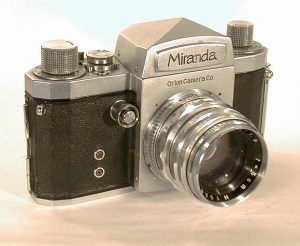
By 1955, Orion was ready to release a production version of the Phoenix, but due to a trademark dispute they had to come up with a different name. They decided to call their new SLR camera the Orion Miranda T. The Miranda T is notable as being the first Japanese SLR with a pentaprism finder. The German company Zeiss Ikon, released the Contax S in 1949 which was the world’s first SLR with a pentaprism finder. Prior to this, all SLR cameras had a waist level viewfinder in which the photographer would flip open a lid on top of the camera and peer down into the body to compose their image.
In an effort to avoid confusion between Orion’s previous camera related products and their new Miranda T SLR, the company completely renamed itself Miranda Camera K.K. which they kept throughout the remainder of the company’s existence.
In the late 1950s, the SLR camera market was still pretty small. The most common types of cameras sold were rangefinder or viewfinder cameras. Professional photographers would gravitate towards TLR cameras that were easier to use and had better optics. Miranda was the only company in the world at this time who strictly made SLR cameras. While this proved to be beneficial as they were able to put all of their focus on making quality cameras with great features, it proved to be the downfall of the company.
In the late 50s Miranda formed a very strong relationship with an American import company called Allied Impex Corporation (AIC). For a reason that I was never able to discover online, in the summer of 1959 Miranda stopped all Japanese domestic sales and all sales were export only to Europe and the United States. Miranda returned to the Japanese market in the fall of 1964 but continued to be heavily influenced by AIC, eventually being acquired by AIC by the end of the decade.
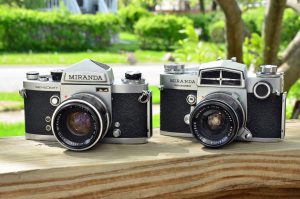
The Miranda Sensomat was introduced in 1969 and continued until about 1975. The Sensomat was a budget model version of their popular Sensorex line of cameras which came out in 1966. The Sensorex was the first Miranda camera to offer through the lens CdS metering. The Sensorex featured an external coupling arm that the Sensomat lacked. This arm linked the meter to the aperture of the lens. This allowed the photographer to measure exposure with the lens at maximum aperture, and then stop down only when firing the shutter. Metering at maximum aperture allows the photographer to compose and focus their shot at the same time while the camera is measuring exposure. Without this feature, you must first compose your shot, then stop down the lens to the desired aperture and then meter. This additional step slows down the process of taking the picture. If you were to look at a Sensomat and Sensorex side by side, other than the name and the redesigned prism, you’ll notice that the Sensomat has two buttons (later models only had one) on the front of the camera for activating the meter.
After Miranda went bankrupt, the “Miranda” name was reused in the late 80s by a completely unrelated company who made a cheap line of point and shoot cameras. It’s also worth mentioning that there was also an unrelated Japanese company also called Orion Seiki who made a line of folding cameras in the 1950s that predates the Orion/Miranda company. The presence of this company could have also contributed to why the Orion Camera Company changed its name to Miranda but I never found any conclusive evidence during my research.
Today, Miranda cameras have a loyal following among camera collectors and people who still like to shoot vintage cameras. All Miranda cameras are well built solid pieces of metal, and many surviving copies still work as good as they day they were made. Like any vintage camera, they are prone to light leaks and slow shutters, but once they’re cleaned up, they are just as good of an example of a 1960s SLR as anything else out there.
Many of the features that made them popular in the 1960s such as the interchangeable prism, front shutter release button, and dual lens mount still make them appealing today because of their uniqueness. The Sensorex line sold the best back in the 60s and early 70s, so finding one today is not hard. Because the company did not survive the mid 70s and there is no legacy to build on, many of the Sensorex and Sensomat cameras sell for very cheap. The oldest Mirandas, specifically the original Orion Miranda T are extremely collectible and sell for outrageous prices.
My Thoughts
Over the past 100 or so years, there have been MANY brands of cameras that have come and gone. There are literally hundreds of names like Bolsey, Univex, Certo, Ihagee, Topcon, Royer, Meopta, and Praktica who all made one or more type of cameras. Some were successful, some not so much. The thing about obscure camera brands is that the design of these cameras is also quite a bit different from what we typically see today.
Miranda cameras however, have a look that is still pretty modern. The design of their 60s and 70s SLRs still look very much like modern DSLRs. If you were to cover up the name plate on a 60s Miranda and put it next to a comparable Nikon or Canon from the same era, and ask the average person to tell you which one is the obscure camera company, they probably couldn’t do it.
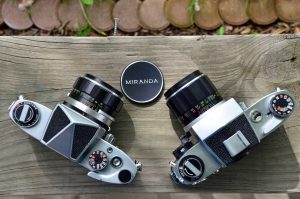
The first time I saw a Miranda, I thought it looked so modern, yet I didn’t recognize the name. The removable prism and front shutter release have a cool factor that most 60s and 70s SLRs lack. Adding to the fact that they’re relatively easy to find cheap, I started to look for one. I didn’t specifically set out to get a Sensomat, but the one I found was in great shape and came with two lenses and a case. The seller said the camera was in excellent shape, the lens was clear and free of mold and fungus, and that the shutter worked.
When the camera arrived, I was pleased to see that the seller had mostly described the condition of the camera accurately. I have observed that the mirror on my example does occasionally stick on slow shutter speeds, but not on any speeds I would feel comfortable using hand held. The shutter isn’t actually sticking, so thankfully, the exposure doesn’t get ruined, but since the mirror won’t flip back down, I have to waste a frame to get it to reset.
The lenses and body were in great shape and the camera needed just a general wiping down to look in near mint condition. There were only two physical problems, a very small ding in the metal at the top of the prism and for some reason, there are two screws missing from the underside of the prism. Since the prism is removable on this camera, I could just find one in mint condition, swap it with mine and the whole camera would be perfect.
The Miranda Sensomat is the only camera I own that requires a PX675 battery, and since there is no easy alkaline, silver-oxide, or lithium replacement, I ordered a PX675 Wein cell from Amazon. Most battery powered cameras from before the mid 1970s used a 1.35v Mercury cell which are no longer made. Although many Mercury batteries have modern equivalents of the same size, the PX675 isn’t one of them. Wein cells are a type of zinc battery with a special diode soldered onto the battery itself which reduces the voltage to the correct 1.35v. I was unable to test the meter in the Sensoret until after I had the battery, but once I did, I was pleased to see that the meter worked too.
For one reason or another, once I had the Miranda in good working condition, it took me a couple of months to actually put some film into it and start shooting, but once I did, I was reminded at why I bought this camera in the first place. It truly is a wonder to hold. The Miranda feels a like a solid piece of metal in your hands. Yes, I know there are probably hundreds of individual gears, levers, and springs inside of the body, but this thing is so solid in your hands, it exudes quality. I might be wrong, but I don’t think there is a single piece of plastic anywhere on the camera, even the lens cap is metal.
Firing the shutter gives a satisfying click, but its not as loud as other focal plane SLRs I’ve heard. The Miranda cameras had a soft return mirror which probably helps with this, as this is one of my quieter SLRs. The viewfinder has a Fresnel screen with microprism center, that is reasonably bright for a 1960s era SLR. Its not as bright as a modern Nikon or SLR, but for a 60s camera, it is still very usable.
So, after playing around with the camera and getting a feel for its functions, I loaded some film into the camera and went out shooting.
My Results
Using the Miranda Sensomat has strong similarities to other SLRs of the era, and a few things that are notably different. The first, and most obvious is the front shutter release button. Although there were other cameras that had a shutter release on the front of the camera, none were ones I had ever used. It does take a bit of getting used to, but I really like it. When I pick up any camera off a table, I instinctively put my right index finger on the grip. I don’t naturally put it on the top plate of the camera. Although we have become conditioned to position our index finger where the shutter release is on most cameras, I don’t think its the most natural position. Having it on the front allows a more secure grip of the camera, and since the squeezing motion of your finger pulls the camera towards your face, rather than down, it has less of a chance at moving the camera while firing the shutter.
Another difference with the Sensomat is in how you activate the meter. Many companies would activate their meter with some type of switch or dial to turn it on or off, but the problem with that is you could accidentally leave the meter on and drain your battery. Nikon had a great idea where the meter comes on when you pull back on the film advance lever to the first position. Fold the meter back into the body, and the meter turns off.
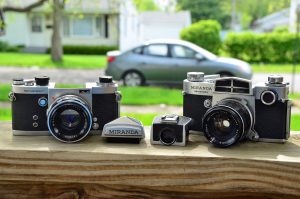
Miranda has a button on the lower left front part of the camera (from the photographer’s perspective) that activates the meter. On the Sensomat, there are actually two buttons in this area, one larger than the other. The larger one is closer to the bottom of the camera and acts as the main meter power switch. The smaller button acts both as a temporary meter switch, but also as a button to cancel the main meter switch. Even if you press the larger button, the meter still will not activate unless you cock the shutter. This is an additional safeguard to prevent you from accidentally leaving the meter on.
The Sensomat is not capable of open aperture metering, which means it must stop down the lens in order to meter properly. Stopping down the lens means that the aperture closes to your chosen size, which decreases the amount of light that enters the viewfinder. This makes it harder to focus on your subject unless you just happen to be shooting at the widest aperture.
So, when composing your shot, the process is to cock the shutter, compose your shot through the viewfinder and get things in focus, then press the larger button to activate the meter. The meter is represented by a ‘match needle’ in the viewfinder which is typical of cameras of this era in which there is a Positive sign and a Negative sign, and then a needle. The needle moves according to the amount of light reaching the meter. If the needle is pointing to the Positive sign, it means you are overexposed and you must change shutter speed or aperture until the needle moves to the middle. If the needle points to the Negative sign, it means you are underexposed. Make changes to either shutter speed or aperture until the needle is halfway between the Positive and Negative signs. Once the needle is there, you are at the correct exposure and you can release the shutter. Firing the shutter will automatically turn the meter back off, and if you need it for the next shot, you must repeat this whole process. If you decide after you have reached proper exposure, that you want to refocus your shot, you need to press the smaller button on the front of the camera to deactivate the meter and return the lens to full aperture. Firing the shutter will properly stop down the aperture to your desired setting, regardless if the meter was on or not.

The final difference with the Miranda is the interchangeable viewfinder. As I only have eye level viewfinders for both of my Mirandas, I was not able to test any of the other options, but if you remove the viewfinder, you can still use the camera without any viewfinder attached. It will work like a TLR where the image is reversed, but otherwise, everything else functions normally, including the match needle, will work fine.
Otherwise, the camera works like any other SLR of the era. Set the shutter speed using a dial on top of the camera, change aperture on the lens, there’s a frame counter, a rewind knob, and a film advance lever. Even loading the film is like on any other 35mm SLR.
I guess when you get into this hobby, you can’t always be lucky. And so far, I’d say I’ve had incredible luck that the majority of the cameras I’ve acquired have been in great working order with only mild repairs or cleaning necessary.
My tale turns towards the “yeeeah buuuutttt” end of the spectrum with the Miranda Sensomat. None of you would know this, but I usually start these reviews weeks, or even months ahead of finishing them. In early May, 2015, I posted my Kiev 4 review which I started on back in December of 2014. This Miranda review has been sitting in my draft folder about as long as that Kiev review was partially because of the problems I’ve had with it.
Now that I am about to post this, I have gone through 2 different rolls in this camera, bought a second “parts” Miranda, and come across 3 different problems in addition to the original problem where the mirror occasionally sticks up on the slower speeds. I fear this camera is hopeless, and since Miranda’s are so uncommon, the likelihood I’d ever find enough information to repair it means that this might end up being a shelf queen. If it were a lesser camera, I’d probably try to sell it, but I still do like the design of it. Plus, I now have 3 lenses and a 2x teleconverter that work with it, so if I ever do find another Miranda that’s in good working order, I’ll be all set.
Of the 4 problems I’ve discovered with this camera, one was an oversight on my part in that it was completely missing the film pressure plate on the back door of the camera. Since there was no pressure plate, there was nothing there to keep the film flat, which means that the film had moved slightly away from the film plane, causing all of the shots to be out of focus.
The missing pressure plate was easily resolved by swapping the one out of the Miranda Sensorex parts camera I had acquired. Even though the two Mirandas were different models, thankfully the pressure plates were inter changeable. Although this was an easy fix, I had to lose an entire roll of film to find out about it.

The next problem cropped up on my second roll when I noticed that the film door was not staying shut. I was sure to get the door latch in the correct position, but all it took was very little effort and it would pop back open. I still do not know why this problem never occurred with the first roll, but whatever the case, it turned out that the door was slightly bent outward. I gently “persuaded it” back into position and it stopped popping open. But this caused me to lose about a third of the second roll.
So far, I was able to correct the issue with the missing film plate and film door, and the sticking mirror only occurs at slow shutter speeds, so as long as I stay with fast shutter speeds, I should be OK, right?
The third problem, and the one that basically kills this camera, is that there is clearly some type of shutter issue where the second (or rear) curtain is “capping” the first. The Miranda uses two horizontally traveling cloth curtains, which was a common way of designing shutters back in the 1960s. The earliest Leicas from the 1930s had cloth curtains along with pretty much every Soviet clone from the 50s and 60s. Cloth curtains were still in common use as recently as the early 1980s with the Canon A-series SLRs.
Cloth curtains are literally rectangular pieces of fabric, usually with some type of light resistant rubberized coating, attached via cloth straps to spring loaded rollers. When you “cock” the shutter, both curtains are pulled across the film plane and tensioned by springs in the rollers. When a specified shutter speed is selected and the shutter is released, the first curtain springs open first, and then a delay causes the second shutter to separate from the first one, exposing the film plane.
For example, if you selected a 1 second shutter speed, both curtains are tensioned at the same time when the shutter is cocked. When the shutter is released, the first curtain springs back to its original position, and the second one is held, for 1 second which exposes the film. After a 1 second delay, the second curtain is released, and it springs back to its original condition, covering up the film plane again. Choose a faster speed, and the same thing happens, but the delay is decreased between the two curtains springing back to their original positions.
The problem with my camera is most likely the second curtain is either getting stuck, or not staying open the entire time it is supposed to. It is traveling approximately halfway across the film plane before separating. This is why the right side of the image is all black, and the left side is exposed. Basically, both curtains are staying completely shut through half the frame before finally separating at the midway point.
This probably isn’t an easy fix. There’s either some kind of debris causing the shutters to not move as expected, or its possible that whatever springs maintain the tension on the curtains, is failing and need to be replaced. Changing the spring tension is actually pretty simple on Leica clones. I have a Soviet era FED 2 camera where there are two screws at the bottom of the camera which can change the spring tension. Sadly, the Miranda was not designed this way.
Despite all of these challenges, I actually did get a couple of shots out of this camera. I mentioned earlier that I have 3 lenses for this camera. I have a 50mm f/1.8, 28mm f/2.8 and a 200mm f/4 lens. I also have a 2x teleconverter which doubles the focal length of any lens it is attached to. Pair that with the 200mm lens, and its like I have a 400mm monster! All of them are Miranda branded lenses and all are in pretty good condition. My plan with this roll was to use all 3 lenses and see which ones perform the best. Sadly, since most of the exposures either became exposed due to the door opening, or have the shutter capping issue, I only received a couple decent shots. Here are the best from the roll.
Additonal Resources
http://www.mirandacamera.com/
http://camerapedia.wikia.com/wiki/Miranda
http://en.wikipedia.org/wiki/Miranda_Camera_Company
http://www.photoethnography.com/ClassicCameras/index-frameset.html?MirandaSensorex.html~mainFrame
http://camera-wiki.org/wiki/Miranda_Sensomat



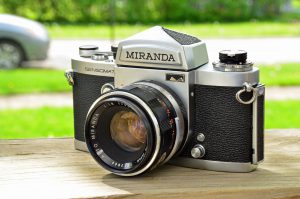








Sorry about your troubles with the Sensomat!! I have a Sensomat, Sensorex, a Sensorex II, and
2 – Sensorex EE’s. I’ve been photographing for real, not as a kid, since 1973 or so. I shot my best ever B&W photographs with my Sensorex, and a roll of Ilford Delta 100…….super sharp, with amazing detail…..I’m sold on Mirandas!
My first Miranda was the Sensorex II, that I took to a camera repair man to do a CLA, and fix the light meter. He sent it back saying it wasn’t worth fixing, and that the light meter was inoperable….
At home, I turned the meter on and off twice, then it sprang to life, and works fine…..!
Thank you for your thorough, and comprehensive reviews…..yours are the best around!
Maybe I’ll see you around Chicago sometime
My first real camera was a Miranda Sensomat. I worked all summer in High School to pay for it and bought it at Olden Camera in Manhattan. My Uncle tought me photography and stressed the importance of ergonomics and had me try the cameras in the shop to see how they felt in my hand. The Miranda was perfect. It lasted for about six years until it needed a major repair in 1974. I bought a Nikkormat FTN which I still shoot with today and gave the Miranda to my ex-Girlfriend. I wonder if it held up or broke again.
It was a great camera and I loved the way it felt in the hand. The detachable pentaprism was nifty too!
Hey! Saw a Miranda for sale and researching brought me here. I’m not going to buy it, but maybe you’re still looking. https://www.shopthesalvationarmy.com/Listing/Details/259167044/Miranda-Sensomat-35mm-Camera-WLens-Case-Not-Tested-G5